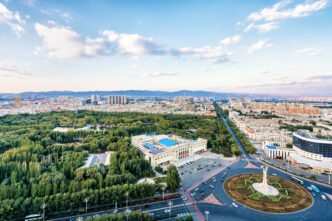Executive Summary
- China plans to hold a ceremony in 2025 to commemorate the 80th anniversary of what it calls the “retrocession” of Taiwan to Chinese rule, reinforcing its historical claims over the self-governed island.
- The term “retrocession” refers to the period after Japan’s defeat in World War Two, with the 1943 Cairo Declaration and 1945 Potsdam Declaration stating Taiwan would be “restored” to the Republic of China.
- Taiwan’s sovereignty remains a complex and contested issue, as the 1951 San Francisco Peace Treaty left its ultimate status unresolved, and the island became the refuge for the Nationalist government after the Chinese Civil War.
The Story So Far
- China’s planned “retrocession” ceremony in 2025 is rooted in Beijing’s historical claim that Taiwan was returned to Chinese rule after Japan’s defeat in World War Two, based on declarations like Cairo and Potsdam. This assertion of sovereignty, however, is a complex and contested issue, with differing interpretations of post-war treaties that left Taiwan’s ultimate status unresolved, further complicated by the division of China in 1949 when the Nationalist government retreated to Taiwan following the civil war.
Why This Matters
- China’s planned 2025 ceremony to mark the 80th anniversary of Taiwan’s “retrocession” serves as a potent public reiteration of Beijing’s unwavering sovereignty claims over the self-governed island, intensifying cross-strait tensions and underscoring the profound historical and political divisions that continue to define the contentious relationship between Beijing and Taipei.
Who Thinks What?
- China asserts that Taiwan was “retroceded” to Chinese rule following World War Two, citing the Cairo and Potsdam Declarations as the basis for its historical claims over the self-governed island.
- Taiwan’s Republic of China government views the 1945 handover and the 1952 Treaty of Peace with Japan as confirmation of sovereignty transfer to the Republic of China.
China has announced its intention to hold a ceremony in 2025 to commemorate the 80th anniversary of what it refers to as the “retrocession” of Taiwan to Chinese rule following the end of World War Two. Sources familiar with the plans indicate the event is slated to occur this weekend in Beijing’s Great Hall of the People, underscoring Beijing’s historical claims over the self-governed island.
Historical Context of “Retrocession”
The term “retrocession” refers to the period after Japan’s defeat in World War Two. In 1943, the Cairo Declaration, signed by China’s Chiang Kai-shek, U.S. President Franklin Roosevelt, and British Prime Minister Winston Churchill, stated that Taiwan would be “restored” to the Republic of China. This declaration was reaffirmed by the Potsdam Declaration in 1945, which called for Japan’s unconditional surrender.
Following Japan’s surrender, Taiwan was formally handed over to the Republic of China government on October 25, 1945. This event is central to Beijing’s narrative of Taiwan’s return to Chinese sovereignty.
Contested Sovereignty and Treaties
The sovereignty of Taiwan, however, remains a complex and contested issue. In 1951, Japan signed the San Francisco Peace Treaty, renouncing its claims to Taiwan, but the document notably left the island’s ultimate sovereignty unresolved. Beijing has consistently declared this treaty “illegal and invalid,” citing its exclusion from the signing.
A year later, in 1952, the Treaty of Peace between the Republic of China and Japan was signed, which reaffirmed Japan’s renunciation of its claims. Taipei views this as confirmation of the previous transfer of sovereignty to the Republic of China. To this day, the governments in Taipei and Beijing do not officially recognize each other, with the Republic of China remaining Taiwan’s formal name.
Taiwan’s Path from Imperial Rule to Division
Taiwan’s modern history began a significant turn in 1895 when China’s Qing dynasty ceded sovereignty over the island to Japan following its defeat in the First Sino-Japanese War. Japanese colonial rule lasted for 50 years.
The overthrow of the Qing dynasty in 1911 led to the declaration of the Republic of China the following year. However, internal strife escalated into the Chinese civil war in 1927, pitting the Chinese Communist Party against the Nationalist government.
Japan’s invasion of Manchuria in 1931, followed by a full-scale invasion of China in 1937, temporarily halted the civil war as both factions resisted the Japanese occupation.
After Japan’s defeat in 1945, the Chinese civil war resumed in 1946. By 1949, Mao Zedong’s Communist forces had prevailed on the mainland, establishing the People’s Republic of China. Chiang Kai-shek’s Nationalist government retreated to Taiwan, with Mao vowing to “liberate” the island.
An uprising against the ruling Republican Chinese government in Taiwan in 1947, fueled by social, cultural, and political tensions, was met with a bloody crackdown, further shaping the island’s unique trajectory.
A Ceremony Amidst Ongoing Tensions
China’s planned ceremony in 2025 to mark the 80th anniversary of “retrocession” highlights Beijing’s unwavering assertion of its sovereignty over Taiwan. This commemorative event is set against a backdrop of enduring cross-strait tensions and the differing historical interpretations that continue to define the relationship between Beijing and Taipei.








